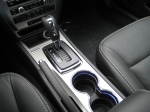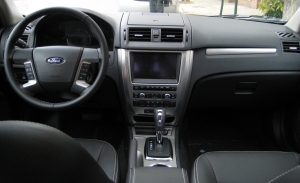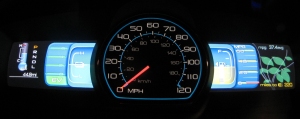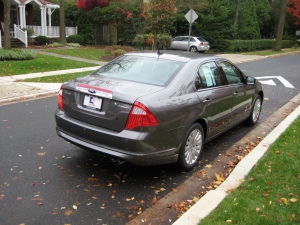 Originally introduced as a 2006 model, the Ford Fusion is a mid-sized car slotted between the compact Focus and the full-sized Taurus. Redesigned for 2010, the Fusion has been an instrumental part in Ford’s reinvention of itself as a quality American car maker. I put emphasis on “car” because Ford’s F-150 truck has been the top-selling truck for a long time, but their cars, as of late, have not garnered much positive praise. To better compete with their rivals, Ford has begun offering a hybrid version of the Fusion, the subject of this review.
Originally introduced as a 2006 model, the Ford Fusion is a mid-sized car slotted between the compact Focus and the full-sized Taurus. Redesigned for 2010, the Fusion has been an instrumental part in Ford’s reinvention of itself as a quality American car maker. I put emphasis on “car” because Ford’s F-150 truck has been the top-selling truck for a long time, but their cars, as of late, have not garnered much positive praise. To better compete with their rivals, Ford has begun offering a hybrid version of the Fusion, the subject of this review.
 The 2010 Fusion has a redesigned exterior, adding Ford’s new corporate “3-bar” grille to a newly-styled front end, and redesigned rear. While the new car isn’t completely changed from the previous Fusion, it’s a more attractive look, which spills over into the interior.
The 2010 Fusion has a redesigned exterior, adding Ford’s new corporate “3-bar” grille to a newly-styled front end, and redesigned rear. While the new car isn’t completely changed from the previous Fusion, it’s a more attractive look, which spills over into the interior.

 Getting into the car, you notice the well-appointed interior, with a fair amount of soft touch materials. If you squint, you’d almost think you’re in a 3-series BMW from earlier this decade. The hood over the instrument cluster, the shape of the air-conditioning vents and the feel of the dashboard pay homage to the Bimmer. Most of the hard plastics in the car are painted an aluminum color or faux carbon fiber pattern, which look good. At night, you’ll notice the illuminated cup holders, part of Ford’s Ambient Lighting feature, along with illuminated foot wells. Sitting in the driver’s seat, you notice how deep and supportive it is, an obvious nod to the Fusion Sport model that Ford offers, and a boon for anyone who likes going around corners, even in a hybrid.
Getting into the car, you notice the well-appointed interior, with a fair amount of soft touch materials. If you squint, you’d almost think you’re in a 3-series BMW from earlier this decade. The hood over the instrument cluster, the shape of the air-conditioning vents and the feel of the dashboard pay homage to the Bimmer. Most of the hard plastics in the car are painted an aluminum color or faux carbon fiber pattern, which look good. At night, you’ll notice the illuminated cup holders, part of Ford’s Ambient Lighting feature, along with illuminated foot wells. Sitting in the driver’s seat, you notice how deep and supportive it is, an obvious nod to the Fusion Sport model that Ford offers, and a boon for anyone who likes going around corners, even in a hybrid.
 The air-conditioning vents are at the top-center of the dash, moving the navigation screen and associated controls lower on the dash. While not my favorite design, the designers of the Fusion at least tried to keep the most often-used buttons and knobs as high on the dash as they could, and the navigation screen is in a decent location height-wise, allowing you to view it without taking your eyes completely off the road. With navigation being such a popular option these days, it’s a wonder more cars aren’t laying out their dashboards like the Lincoln MKS, with the vents off to either side of the navigation screen, which is at the height of the dash. The Cadillac CTS and Mercedes-Benz C-Class also have this design, albeit their designers took slightly different routes, giving their navigation screens pop-up motors, hiding them when not in use.
The air-conditioning vents are at the top-center of the dash, moving the navigation screen and associated controls lower on the dash. While not my favorite design, the designers of the Fusion at least tried to keep the most often-used buttons and knobs as high on the dash as they could, and the navigation screen is in a decent location height-wise, allowing you to view it without taking your eyes completely off the road. With navigation being such a popular option these days, it’s a wonder more cars aren’t laying out their dashboards like the Lincoln MKS, with the vents off to either side of the navigation screen, which is at the height of the dash. The Cadillac CTS and Mercedes-Benz C-Class also have this design, albeit their designers took slightly different routes, giving their navigation screens pop-up motors, hiding them when not in use.
 The review vehicle I drove was equipped with optional SYNC, and the optional navigation package as well, which as I’ve experienced before, is well-designed and easy to use. Alongside the SYNC system, the tester had the optional Sony 12-speaker audio system, which while not as great as some of the other systems I’ve heard, is still far better than the base stereo in most cars. The SYNC system on the Fusion Hybrid also includes an Hybrid Electic Vehicle (HEV) screen, which gives you a visual readout of how the power is being routed through the hybrid system. It’s a neat display, and being in the main navigation touch screen, it is in a good place for your passengers to see. The driver gets a customizable display, split into two LCD screens flanking the speedometer. The information displayed on them can be changed using buttons on the steering wheel, and contain all of the information shown in gauges on regular cars, as well as hybrid-specific information such as whether or not the gasoline engine is running and the state of the hybrid batteries. The display modes can help you stay in EV, or “Electronic Vehicle” mode longer, thereby increasing fuel mileage. Thoughtfully, Ford built a “demo” mode into the display, to get a new hybrid driver up to speed on the functions of the instrument cluster, but anyone who buys a Fusion Hybrid is going to want to spend some quality time with the manual, reading up on all the acronyms used by the car.
The review vehicle I drove was equipped with optional SYNC, and the optional navigation package as well, which as I’ve experienced before, is well-designed and easy to use. Alongside the SYNC system, the tester had the optional Sony 12-speaker audio system, which while not as great as some of the other systems I’ve heard, is still far better than the base stereo in most cars. The SYNC system on the Fusion Hybrid also includes an Hybrid Electic Vehicle (HEV) screen, which gives you a visual readout of how the power is being routed through the hybrid system. It’s a neat display, and being in the main navigation touch screen, it is in a good place for your passengers to see. The driver gets a customizable display, split into two LCD screens flanking the speedometer. The information displayed on them can be changed using buttons on the steering wheel, and contain all of the information shown in gauges on regular cars, as well as hybrid-specific information such as whether or not the gasoline engine is running and the state of the hybrid batteries. The display modes can help you stay in EV, or “Electronic Vehicle” mode longer, thereby increasing fuel mileage. Thoughtfully, Ford built a “demo” mode into the display, to get a new hybrid driver up to speed on the functions of the instrument cluster, but anyone who buys a Fusion Hybrid is going to want to spend some quality time with the manual, reading up on all the acronyms used by the car.
 Which leads me to the question a lot of people have asked me: How does the Fusion Hybrid drive? The answer is a bit more complicated than if it were pertaining to a regular car. The short answer is that the Fusion Hybrid drove well. The real answer, however, is that it is an interesting drive. With the hybrid system, there are a lot of features and functionality to get used to. Accelerating from a dead stop to keep up with normal traffic, the car stays in Electronic Vehicle (EV) mode up until about 5 mph. Then, the gas engine starts up, providing power almost at idle, which gives it a slightly rough start, which smoothes out quickly once you’re getting up to speed. It’s at this point that you can hardly tell you’re in a hybrid car, as the transition from gas to electric and back at any speed over 5 mph is downright seamless. Surprisingly, once you get away from a stop, there is plenty of acceleration to be had, owing to the hybrid motor’s power. At highway speeds, that power seems to drop off quickly, as the electric motor is no longer helping out. The flip side of this is driving in a city, where you have to stop every block or so for stop lights and signs. By accelerating slowly and keeping an eye on the instrument cluster, I was able to keep the Fusion in EV mode for several blocks, boosting my fuel economy by almost 2 mpg. The disconcerting bit here is the car’s transmission. Most people are used to regular automatic transmissions, but some cars have been offered with Continuously Variable Transmissions, or CVTs. The difference in operation between them is slight, the most noticeable being that there are no gear changes on a CVT, so you have a constant engine noise while accelerating.
Which leads me to the question a lot of people have asked me: How does the Fusion Hybrid drive? The answer is a bit more complicated than if it were pertaining to a regular car. The short answer is that the Fusion Hybrid drove well. The real answer, however, is that it is an interesting drive. With the hybrid system, there are a lot of features and functionality to get used to. Accelerating from a dead stop to keep up with normal traffic, the car stays in Electronic Vehicle (EV) mode up until about 5 mph. Then, the gas engine starts up, providing power almost at idle, which gives it a slightly rough start, which smoothes out quickly once you’re getting up to speed. It’s at this point that you can hardly tell you’re in a hybrid car, as the transition from gas to electric and back at any speed over 5 mph is downright seamless. Surprisingly, once you get away from a stop, there is plenty of acceleration to be had, owing to the hybrid motor’s power. At highway speeds, that power seems to drop off quickly, as the electric motor is no longer helping out. The flip side of this is driving in a city, where you have to stop every block or so for stop lights and signs. By accelerating slowly and keeping an eye on the instrument cluster, I was able to keep the Fusion in EV mode for several blocks, boosting my fuel economy by almost 2 mpg. The disconcerting bit here is the car’s transmission. Most people are used to regular automatic transmissions, but some cars have been offered with Continuously Variable Transmissions, or CVTs. The difference in operation between them is slight, the most noticeable being that there are no gear changes on a CVT, so you have a constant engine noise while accelerating.
Overall, the driving experience of the Fusion Hybrid is pretty close to a 4-cylinder Fusion. While the Hybrid may not have as much acceleration from a stop as its gasoline-only sibling, the Hybrid accelerates just as well once speeds climb, with much less fuss and noise.
 The Hybrid handles almost as well as the gas-only Fusions, but the extra weight of the hybrid motor and batteries is evident, and the Fusion Hybrid pays the penalty in curves. It still handles well, but doesn’t feel as light on its feet as the 4-cylinder Fusion. It appears as though Ford aimed again at the BMW 3-series when it tuned the suspension and steering of the Fusion, although it’s not quite there. With front-wheel drive and more of its weight in the front of the car, the Fusion just simply isn’t going to handle like a BMW. When driving over speed bumps or potholes you can feel the suspension work, but it won’t spill your morning coffee, and the steering is set up to tell you exactly where the front tires are pointed, which helps when going around turns.
The Hybrid handles almost as well as the gas-only Fusions, but the extra weight of the hybrid motor and batteries is evident, and the Fusion Hybrid pays the penalty in curves. It still handles well, but doesn’t feel as light on its feet as the 4-cylinder Fusion. It appears as though Ford aimed again at the BMW 3-series when it tuned the suspension and steering of the Fusion, although it’s not quite there. With front-wheel drive and more of its weight in the front of the car, the Fusion just simply isn’t going to handle like a BMW. When driving over speed bumps or potholes you can feel the suspension work, but it won’t spill your morning coffee, and the steering is set up to tell you exactly where the front tires are pointed, which helps when going around turns.
 When ferrying passengers around, you’ll be glad to be in the driver’s seat. Comparatively, the rear seat is just not as comfortable. It’s not overly firm, and there is a good amount of leg room, especially on a car in this class, but the head room was lacking. At only 5’8″, my head was too close to the roof of the Fusion, something which may cause taller passengers to complain if they have to sit there.
When ferrying passengers around, you’ll be glad to be in the driver’s seat. Comparatively, the rear seat is just not as comfortable. It’s not overly firm, and there is a good amount of leg room, especially on a car in this class, but the head room was lacking. At only 5’8″, my head was too close to the roof of the Fusion, something which may cause taller passengers to complain if they have to sit there.
Opening the trunk, you can see that the engineers at Ford had to modify its shape on all sides in order to fit the hybrid battery and other components. There are air flow vents on the sides, and the front and bottom of the trunk are covered in access panels, hiding the batteries and their cooling fans. While the hybrid parts are intrusive, you’re still left with a sizable trunk which can easily swallow a good amount of luggage or groceries, the latter being more likely.
Conclusion:
The redesigned 2010 Ford Fusion Hybrid is a great car. Based on a well-rounded platform which supports a range of options and models to meet almost any commuter’s needs, the Fusion shows Ford’s drive to be competitive in the crowded mid-sized sedan market. Featuring a comfortable and roomy cabin, as well as all the safety and technology options todays commuters want, the Fusion Hybrid has garnered the media’s attention, and should be a strong seller for Ford in the foreseeable future. Recently, it won Motor Trend’s Car of the Year award for 2010, one which should boost its sales even further.
Competitors: Chevrolet Malibu, Honda Accord, Hyundai Sonata, Mazda Mazda6, Mercury Milan, Nissan Altima, Toyota Camry
As-Tested:
Year: 2010
Make: Ford
Model: Fusion Hybrid
EPA Fuel Mileage: 41/36 City/Highway
Base Price: $27,625.00
Options:
$5,215: Rapid Spec 502A (includes Navigation System – Voice Activated, Driver’s Vision Group, BLIS w/Cross Traffic Alert, Rear View Video Camera, Moon & Tune Value Package, Power Moonroof, Sony Sound System – 12 speakers, Leather-trimmed Heated Front Seats)
$345: Powercode Remote Start System
Total: $33,185
Rapid Spec Savings: $1,270
Destination: $725
As-Tested Price: $32,640
Ford has an online Window Sticker viewer. Click here to view the Window Sticker for the actual test vehicle.
Special thanks to Steve Fransisco and Century Ford of Mt. Airy, MD for loaning the tester to Road Reality. Click here to view their web site.
By John Suit


